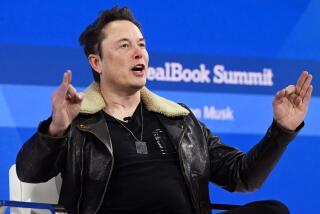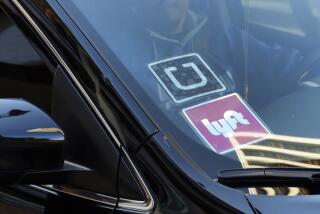Uber’s self-inflicted controversies come at a price: public loyalty

In a statement to Uber employees, Kalanick apologized and said he intends to seek leadership help. (March 1, 2017)
- Share via
Uber founder Travis Kalanick has run his hyper-competitive business under the assumption the ride-hailing service that reigns supreme will be the one with the cheapest rates and best service.
On that count, the 40-year-old chief executive has won handily. Uber has the most cars on the road and often the lowest prices.
But in recent months, the San Francisco firm has discovered customers care about more than just cost and service. People have to actually like your brand. But that’s hard to do when your company is battered by one self-inflicted controversy after another.
Since the start of the year alone, Uber has had to address criticism over:
- Its ties to President Trump
- A wide-ranging sexual harassment allegation from a former employee
- A lawsuit by Google alleging the theft of trade secrets
- The resignation of the company’s senior vice president of engineering for not disclosing another sexual harassment claim
- And most recently, dashcam footage showing Kalanick losing his temper with one of his drivers that went viral.
In the latest spat, Kalanick lashed back at a driver who said he had lost money working for Uber’s high-end black car service. “Some people don’t like to take responsibility for their own [expletive],” he told the driver. “They blame everything in their life on somebody else.”

The embattled company is now fighting to retain drivers and customers while dealing with an image crisis that would make most Fortune 500 leaders lose their lunch. Its sweet justice for critics of the company, which has ignored regulators, clashed with legacy taxi providers and declined to guarantee its drivers a minimum wage. Uber’s winner-take-all attitude may have helped it become the nation’s biggest ride-hailing service, but now it seems to be scaring away consumers with a conscience.
The company seems to have left behind what matters the most: people.
— Fabian Geyrhalter
“By focusing solely on the next round of funding and speedy economic growth, the company seems to have left behind what matters the most: people,” Fabian Geyrhalter, the head of Los Angeles-based branding agency Finien, said of Uber’s treatment of its employees, drivers and clientele.
When Uber launched in 2009, its service and technology was novel: tap your smartphone, get a ride from a friendly driver in a clean vehicle with new-car smell, all for a price comparable to a taxi.
But “today, the only brand attribute left is ‘cheap’ and the Uber brand took a massive hit because of greed and a one-track mind that left the life force of a functioning company behind,” Geyrhalter said.
The negativity doesn’t just hit ridership, which witnessed a reported loss of more than 200,000 users since Kalanick showed willingness to work with the president. Experts say it could also weaken the company’s ability to recruit talented employees, particularly women. Moreover, it’s already weighing on the patience of Uber’s investors, who see Kalanick’s abrasive leadership style and the questionable culture it fosters as an eventual impediment to a successful public company one day. Venture capitalists Mitch and Freada Kapor published a letter last week describing Uber’s culture as “toxic.”
“Travis is competing in several markets here,” said Duncan Davidson, general partner at Bullpen Capital, which is not an investor in Uber. “One is competing with Lyft and taxies. The other is competing for capital. And the third is talent. This is going to hurt him.”
None of this is particularly shocking to anyone who has followed Kalanick, whose cutthroat reputation and Ayn Rand worldview hasn’t engendered much goodwill outside of Libertarian circles and venture capitalists’ offices. Apple’s Steve Jobs wasn’t particularly liked either because of his caustic management style, but his products were so transformative that he was labeled a genius above all else.
Kalanick doesn’t have that luxury. Ride-hailing just isn’t that sexy. And so the chaos at his company is seen as a reflection of his leadership.
“Leaders create the weather and they control the weather,” said Scott Eblin, an executive leadership coach who has also written bestselling books on the topic. “If you look at Uber’s history and how aggressive they’ve been in their expansion, it wasn’t that surprising that they’ve run into trouble because it’s a super aggressive, takes-no-prisoners kind of culture. That starts with Kalanick. It’s played out to its logical conclusion.”
Davidson said the missteps put more pressure on Kalanick than ever before to change his act.
“He created this bad boy culture, he broke the rules and was able to defeat the taxi cab industry, and everyone applauded him for it, but he’s going to start getting in trouble now,” Davidson said. “Like Trump has to get more presidential, Travis needs to start being a leader, and not be a feisty little start-up bad boy. It’s a transition everybody has to make, and he’s taken way too long to make it.”
Uber did not respond to a request for comment, but Kalanick issued an apology Tuesday night for the argument with his driver caught on video.
“To say that I am ashamed is an extreme understatement,” Kalanick wrote. “It’s clear this video is a reflection of me.… I must fundamentally change as a leader and grow up. This is the first time I’ve been willing to admit that I need leadership help and I intend to get it.”
A more carefully cultivated public image can make a difference. Consider Uber’s chief rival, Lyft. Neither of the privately held, venture-backed companies offers benefits to its drivers, perhaps the most controversial aspect of the ride-hailing business model. Yet Lyft has succeeded in promoting a softer image with its plush, pink mustachioed vehicles. In an industry where there’s little difference between competitors, Uber is leaving money on the table simply because Lyft is viewed as being nice.
Uber’s belligerence is so well-known in Silicon Valley that competitors don’t even have to bring it up as a point of differentiation any more when it comes to recruiting and retaining talent, according to sources at Lyft, who declined to be named because they weren’t authorized to speak on the matter.
The question now is how long the backlash will last.
After Uber appeared to advertise low fares during a taxi workers strike at John F. Kennedy International Airport protesting President Trump’s travel ban, the hashtag #deleteUber trended and thousands of users removed the app from their phones (Lyft was there too, but few complained, likely because of the company’s comparatively benign reputation).
Tiffany Seeley, 27, was one of those users. The UX designer and fan of Uber’s design said she deleted her account after learning about the company’s response to the Trump administration’s travel ban and in protest of Kalanick’s participation on the president’s economic advisory council. She even wrote the CEO a letter, she said.
But within about a week, Seeley said, she was back to using Uber.
“I realized I needed it,” she said, describing the convenience of hailing an Uber from her loft in downtown L.A. and being picked up and dropped off without having to think about it. “It’s all done for me.”
With a valuation of $68 billion compared with Lyft’s $5.5 billion, Uber isn’t likely to lose its dominance any time soon. But the controversies could ultimately diminish that valuation. Kalanick, experts say, will have to show a humbler side of the company moving forward if it hopes to extend its growth.
“Arrogance works if you’re Babe Ruth and you hit a home run where you pointed or you’re Muhammad Ali and you get a knockout in the first round,” said Ira Kalb, a professor of marketing at USC. “If you don’t deliver on arrogance, that’s when the marketplace is very unforgiving. That’s sort of what’s happening with Uber now.”
Times staff writer Nina Agrawal contributed to this report.
Follow @traceylien and @dhpierson on Twitter
ALSO
For brash Uber, Google’s accusation of theft isn’t even its worst news
Uber CEO pledges to ‘grow up’ after video shows him lashing out at a driver
Uber executive leaves after failing to disclose sex harassment allegation
More to Read
Inside the business of entertainment
The Wide Shot brings you news, analysis and insights on everything from streaming wars to production — and what it all means for the future.
You may occasionally receive promotional content from the Los Angeles Times.












